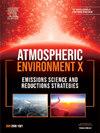Estimation of the primary air pollutant emission levels of in-use gasoline vehicles and their influencing factors in Beijing, China
IF 3.8
Q2 ENVIRONMENTAL SCIENCES
引用次数: 0
Abstract
Gasoline vehicles (GVs) have become one of the main emission sources of NOx and volatile organic compounds (VOCs) in Beijing, and determining the pollutant emission levels of in-use GVs is crucial. In this study, we assessed the emission levels, exceedance rates, and factors influencing primary air pollutants (NO, CO, and hydrocarbons (HCs) from GVs, including 7.46 million GVs in Beijing from 2019 to 2023. We predicted the variation in the exceedance rate after implementing the standard b-limit and assessed the social stability risk. In general, the emissions of GVs in Beijing were relatively low. According to the simple driving mode conditions, the CO, HC and NO concentrations in the top 50% of the cumulative probability distributions of emissions were 0.04%, 10.3 ppm and 77.0 ppm, respectively, which account for only 1/10∼1/8 of the standard a-limit values. However, we found that the pollutant concentrations corresponding to the top 10% and 90% of the cumulative probability distributions significantly differed. For example, the NO concentrations in the top 10% were 220 times greater than those in the top 90%, namely, approximately 36.5% greater than the standard limit. The greater risk of exceeding the standards was related to the occurrence of carbon deposits on the valves and cylinder heads of engines, of which medium-duty trucks (MDTs) exhibited the highest rate of exceeding the standards (34.5%) due to vehicle deterioration under high-intensity use. GVs exhibited the highest exceedance rate among all the vehicle types, at 38.7%, whereas China VI vehicles exhibited an exceedance rate of only 0.2%. If the more stringent standard b-limit were implemented, the number of vehicles exceeding the standard would increase, and the exceedance rate of GVs under the standard b-limit would be slightly greater than that under the a-limit. Overall, the exceedance rate showed a decreasing trend with increasing emission stage, with the proportion of the exceedance rate at the different emission stages also varying.

北京市在用汽油车一次大气污染物排放水平及其影响因素分析
汽油车已成为北京地区氮氧化物和挥发性有机物的主要排放源之一,在用汽油车污染物排放水平的确定至关重要。本研究以北京市2019 - 2023年746万辆gv为研究对象,评估了gv的排放水平、超标率和主要空气污染物(NO、CO和碳氢化合物)的影响因素。我们预测了实施标准b限值后的超标率变化,并评估了社会稳定风险。总体而言,北京的gv排放量相对较低。在简单驾驶模式条件下,CO、HC和NO浓度在排放累积概率分布的前50%分别为0.04%、10.3 ppm和77.0 ppm,仅占标准a限值的1/10 ~ 1/8。然而,我们发现累积概率分布的前10%和前90%所对应的污染物浓度存在显著差异。例如,前10%的NO浓度是前90%的220倍,约为标准限值的36.5%。发动机气门和气缸盖的积碳率较高,其中中型载重汽车在高强度使用下由于车辆劣化导致的积碳率最高(34.5%)。在所有车型中,gv的超标率最高,为38.7%,而国六车辆的超标率仅为0.2%。如果实施更为严格的b标准,超标车辆数量将会增加,并且b标准下的gv超标率略高于a标准。总体而言,随着排放阶段的增加,超标率呈下降趋势,不同排放阶段的超标率所占比例也有所不同。
本文章由计算机程序翻译,如有差异,请以英文原文为准。
求助全文
约1分钟内获得全文
求助全文
来源期刊

Atmospheric Environment: X
Environmental Science-Environmental Science (all)
CiteScore
8.00
自引率
0.00%
发文量
47
审稿时长
12 weeks
 求助内容:
求助内容: 应助结果提醒方式:
应助结果提醒方式:


